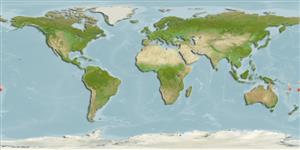>
Gobiiformes (Gobies) >
Gobiidae (Gobies) > Gobiinae
Etymology: Eviota: No etymology given, suggested by Christopher Scharpt: from Latin 'eu' for 'true' and 'iota' for anything very small, in combination 'truly very small' referring to it as being the smallest vertebrate at the time it has benn described by Jenkins (thus, making the suggestion by Scharpt plausible; karaspila: Name from the Greek words ' kara' meaning head and 'spilous' for spot; referring to the distinctive occipital spot; an adjective.
More on authors: Greenfield & Randall.
Environment: milieu / climate zone / rango de profundidad / distribution range
Ecología
marino asociado a arrecife; rango de profundidad 3 - 23 m (Ref. 85556). Tropical
Western Central Pacific: Fiji and possibly Tonga.
Tamaño / Peso / Age
Madurez: Lm ? range ? - ? cm
Max length : 1.8 cm SL macho / no sexado; (Ref. 85556); 1.7 cm SL (female)
Short description
Claves de identificación | Morfología | Morfometría
Espinas dorsales (total) : 7; Radios blandos dorsales (total) : 9; Espinas anales: 1; Radios blandos anales: 8. This species is distinguished from its congeners by the following set of characters: a dark, prominent occipital spot; eye 33.7-39.3% HL; caudal-peduncle depth 10.3-12.9% SL; slender body 16.7- 21.3% SL; no dark spots on nape and dorsal midline of trunk; dorsal/anal fin-ray formula 9/8; pectoral-fin rays 16-17, some are branched; cephalic sensory-pore system pattern group I (complete); 5th segmented pelvic-fin ray 8-16% of 4th ray; non-fimbriated genital papilla; absence of 2 orange patches behind the eye in live or fresh individuals (Ref. 85556). Dorsal to anal fin-ray formula 9/8 (Ref. 116739).
Body shape (shape guide): fusiform / normal.
rotenone
Life cycle and mating behavior
Madurez | Reproducción | Puesta | Huevos | Fecundidad | Larva
Greenfield, D.W. and J.E. Randall, 2010. Eviota karaspila, a new gobiid fish from Fiji (Teleostei: Gobiidae). Zootaxa 2672:61-68. (Ref. 85556)
IUCN Red List Status (Ref. 130435: Version 2025-1)
Threat to humans
Harmless
Human uses
Herramientas
Special reports
Download XML
Fuentes de Internet
Estimates based on models
Preferred temperature (Referencia
123201): 26.4 - 28.9, mean 27.1 °C (based on 156 cells).
Phylogenetic diversity index (Referencia
82804): PD
50 = 0.5000 [Uniqueness, from 0.5 = low to 2.0 = high].
Bayesian length-weight: a=0.01023 (0.00477 - 0.02194), b=3.01 (2.83 - 3.19), in cm total length, based on LWR estimates for this (Sub)family-body shape (Ref.
93245).
Nivel trófico (Referencia
69278): 3.0 ±0.3 se; based on size and trophs of closest relatives
Fishing Vulnerability (Ref.
59153): Low vulnerability (10 of 100).
🛈
Nutrients (Ref.
124155): Calcium = 488 [204, 1,989] mg/100g; Iron = 2.23 [0.84, 5.32] mg/100g; Protein = 18 [16, 20] %; Omega3 = 0.163 [0.044, 0.615] g/100g; Selenium = 37.1 [8.9, 124.3] μg/100g; VitaminA = 97.9 [15.5, 588.5] μg/100g; Zinc = 5.87 [2.88, 10.52] mg/100g (wet weight);
